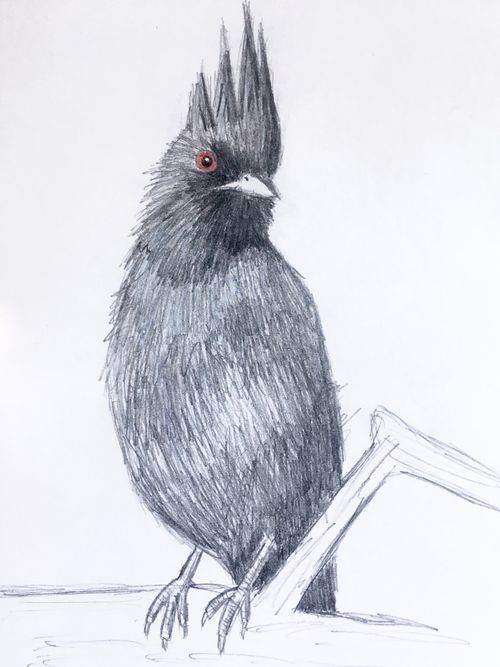The Phainopepla is a curious bird
The Phainopepla is a curious bird. Their tall crest and feathers of silky black or gray are accentuated by piercing blood-red eyes. They reveal bright white wing patches in their somewhat slow yet buoyant flight. In the Sonoran Desert they fiercely defend their clumps of desert mistletoe from intruders with an inquisitive “Wert?” A charming and charismatic bird at first glance, the closer one looks into any aspect of its natural history, one realizes why Allan Philips claimed in The Birds of Arizona: "Phainopeplas have no respect for the rules."

The Phainopepla song is a modest volume series of burry and polyphonic phrases, evocative of blackbird and shrike vocalizations in their complexity. Those that work closely with Phainopepla have noted a bizarre vocal behavior when they're distressed while being handled: they unleash a near constant stream of loud (and very convincing) imitations. These include a variety of hawk and other predator calls, perhaps in an attempt to distract or frighten, but they also mimic a wide variety of small harmless songbirds. Investigating this behavior, there is a study that shows a variety of imitations mixed with alarm calls is most effective at rallying other nearby species to help mob a predator. When threatened, the Phainopepla vocally simulates a multi-species scolding mob attempting to drive a predator away. This in turn helps manifest a real mob with real birds. Avian aural Twitter bots.
Under normal circumstances one rarely hears these imitations in the field though. I had no idea Phainopeplas were mimics at all when I encountered a lone male singing from the top of a palo verde in the Phoenix Mountains Preserve in January 2019. I could hear the louder burry phrases typical of their song but interspersed throughout were quiet sounds I couldn’t quite make out. I snuck myself under the tree where the bird was singing and with the assistance of my microphone I then could hear what he was muttering. Listen below:
After some introductory phrases he launches into a series of imitations at around 17 seconds in what is referred to as their Quiet Song. In this two minute clip I hear imitations of at least a dozen species, from desert dwelling critters like Curve-billed Thrasher and Harris’ Antelope Squirrel to a variety of higher elevation forest birds like Spotted Towhee, Cassin’s Kingbird, Tree Swallow, and Western Wood-pewee. Unlike the famous mimic, the Northern Mockingbird, which belts out its collection of imitations at the top of its lungs, the Phainopepla whispers them. They can’t be heard from more than a stone’s throw away, so who are they for? Sometimes quiet songs serve to strengthen pair bonds when birds are in close proximity – but I didn't see any other Phainopeplas nearby. Was he practicing? I doubt it – they sound pretty crystallized to me. When listening to the extended recording he uses the same imitations many times with very similar phrasing and delivery. Was he feeling threatened, either by me or something else? Again, I doubt it – giving quiet imitations of birds that are currently hundreds of miles away doesn't seem like an effective mob-eliciting strategy in this context. Whatever the case may be, the function or meaning of imitation seems to be flexible in different contexts. They are very impressive though, why be so coy about it?
Wait a minute, how is this desert-breeder imitating so many forest birds to begin with? Without doing any research we’re already clued-in to a fascinating aspect of this bird’s natural history just by listening to his peculiar quiet song. Clearly, this male has been around. He has seen (and heard) some things.
While Phainopepla are fiercely territorial, mistletoe berry-loving, desert-breeding birds in winter and early spring, they largely vacate the premises by early summer. Around the same time, they are found in mid-elevation riparian and oak woodland habitat, sometimes hundreds of miles away. There they are social creatures, forming loose colonies, nesting together in the same trees, eating berries from the same bushes. They incorporate many more insects into their diet. They’re like a different bird.
For almost a century people have wondered whether these were distinct populations of Phainopepla or the same birds breeding twice a year in different habitats. There are still many details to be worked out but a recent study has shown GPS-tagged desert-breeding Phainopepla do migrate to the expected higher elevation habitats each year and there is no discernible genetic difference between populations in each location. This strongly suggests the same birds breed in both habitats. Aside from a handful of very interesting outliers, most other North American birds are constrained by various environmental, physiological, and behavioral limitations and only have one chance per year to breed. If Phainopeplas are in fact itinerant or migratory double-breeders, “[They] would be behaviorally flexible –in migration, breeding, and social-structure– to a degree not documented in any other North American bird” (Chu, M. and G. Walseberg, Birds of the World, 2020). As for the rules and constructs, generalizations and metaphorical boxes we try to fit birds into, the Phainopepla indeed has no respect for them.
“For he will do as he do do
And there's no doing anything about it”